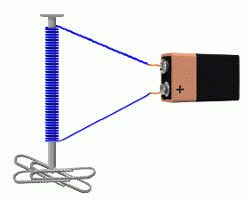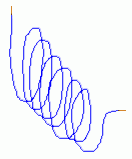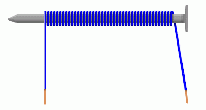
The wire you use must be coated in plastic. It should also be thin enough so that you can wrap it around the nail easily, many times. Wire with a solid copper core works best, since it will stay bent, but you can use stranded wire if you also have some tape to hold the wire loops on the nail.
 Attach the bared ends of the wire to the terminals of the battery. You may need to use a little tape to keep them attached. Either wire can be attached to either terminal ... it doesn't matter.
Attach the bared ends of the wire to the terminals of the battery. You may need to use a little tape to keep them attached. Either wire can be attached to either terminal ... it doesn't matter.The nail has now become an electromagnet. You can test it by picking up small metal objects, like paperclips. The magnet should be quite strong. Electricity flowing in a circuit creates a magnetic field around the wire, just like the field around a magnet. By wrapping the wire tightly around the nail, this magnetic field is concentrated in the space where the nail is, and will magnetize the nail by aligning its atoms in one direction. Electromagnets are used in many kinds of devices, including electric bells, switches, door locks, and motors. |


